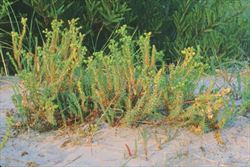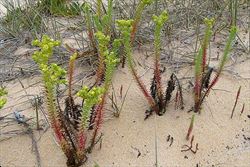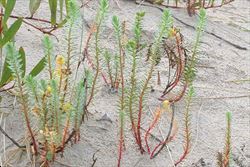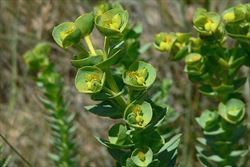Click on images to enlarge

infestation (Photo: Greg Jordan)

habit of mature plants and seedlings (Photo: Jackie Miles and Max Campbell)

habit prior to flowering (Photo: Greg Jordan)

habit in flower (Photo: Jackie Miles and Max Campbell)

upper part of stems showing short flowering branches (Photo: Jackie Miles and Max Campbell)
Scientific Name
Euphorbia paralias L.
Family
Euphorbiaceae
Common Names
sea spurge, spurge
Origin
Native to western and southern Europe (i.e. Ireland, the UK, Belgium, the Netherlands, France, Portugal, Spain, Albania, Bulgaria, Greece, Italy, Romania, Yugoslavia and Ukraine), the Canary Islands, northern Africa (i.e. Algeria, Egypt, Libya, Morocco, Mauritania and Tunisia) and western Asia.
Naturalised Distribution
Widely naturalised in the coastal districts of southern Australia (i.e. in the coastal districts of central and southern New South Wales, Victoria, Tasmania, South Australia and southern and south-western Western Australia). Also recently naturalised on Lord Howe Island.
Habitat
A weed of coastal environs and offshore islands in the temperate regions of Australia. It occurs on free draining sandy soils on beaches, around estuaries, through dune fields, in coastal herbfields, grasslands, heaths and shrublands, and may also grow along rocky shorelines and in sand-filled cracks between rocks.
Habit
A long-lived (i.e. perennial) herbaceous plant with upright (i.e. erect) or semi-upright (i.e. ascending) stems. It usually grows 20-70 cm tall, but may occasionally reach up to 1 m in height. The stems die off after flowering and are replaced by new shoots from the woody base (i.e. crown).
Distinguishing Features
-
a long-lived herbaceous plant with several upright or semi-upright stems (usually 20-70 cm tall) growing from a woody base.
-
its stems are somewhat fleshy, contain a milky sap, and usually divide into branches near their tips.
-
its stalkless leaves (5-30 mm long and 2-15 mm wide) are crowded along the stems.
-
its tiny cup-like, yellowish-green, 'flowers' are borne near the tips of the stems and have a large stalked ovary.
-
its fruiting capsules (3-5 mm long and 4.5-6 mm wide) each containing three seeds.
Stems and Leaves
The stems are often somewhat fleshy (i.e. semi-succulent) and branch from a woody base (i.e. crown). These stems (2-5 cm thick) are hairless (i.e. glabrous), bluish-green (i.e. glaucous) in colour, and contain a milky white sap (i.e. latex). They usually divide into 3-5 flowering branches near their tips, which are often further divided. The stems and leaves often turn reddish as they age.
The bluish-green (i.e. glaucous) leaves are stalkless (i.e. sessile), and relatively crowded or overlapping (i.e. imbricate) along the stems. These leaves (5-30 mm long and 2-15 mm wide) vary from being elongated to oblong, oval (i.e. elliptic) or egg-shaped (i.e. ovate) in outline. However, the leaves on the flowering branches are usually somewhat circular (i.e. orbicular) to kidney-shaped (i.e. reniform) and are paler green or yellowish in colour. The leaves are relatively thick and hairless (i.e. glabrous) with entire margins.
Flowers and Fruit
The inconspicuous 'flowers' (i.e. cyathia) are actually tiny cup-like structures (i.e. involucres) containing several reduced male flowers and one female flower with a very large protruding ovary. These 'flowers' (i.e. cyathia) are clustered at the tips of the branches and are yellowish-green in colour. Each 'flower' (i.e. cyathium) is borne on a separate stalk (i.e. peduncle) and the tiny cup-like structure (about 1.5 mm long) is fringed with four orange crescent-shaped structures (i.e. glands), each of which usually has some short projections. Flowering occurs from spring through to early winter (i.e. from September to June).
The ovary matures into a capsule (3-5 mm long and 4.5-6 mm wide) containing three seeds. These smooth seeds (2.5-3.5 mm long) are egg-shaped (i.e. ovoid) to rounded (i.e. globose) and pale grey or whitish in colour.
Reproduction and Dispersal
Sea spurge (Euphorbia paralias) reproduces by seed and has two main modes of dispersal. The fruit open explosively when mature and expel the seeds short distances. Seeds are also buoyant in sea water, and can be spread very large distances by ocean currents.
Humans can also assist the dispersal of seed, by spreading it about with beach grooming equipment or moving it to new areas in contaminated sand.
Environmental Impact
This species is regarded as an environmental weed in New South Wales, Victoria, Tasmania, South Australia and Western Australia. It was recently listed as a priority environmental weed in two Natural Resource Management regions in southern Australia. Sea spurge (Euphorbia paralias) occurs has successfully invaded many open coastal communities establishing dense infestations and populations of this species may reach tens of thousands where beaches are free of other vegetation or have a low level of plant cover. It can also rapidly colonise eroded areas, such as blowouts, often becoming the dominant plant species.
Sea spurge (Euphorbia paralias) usually intially colonises the foredunes at the back of the beach. It develops dense infestations in this zone that stabilise the dunes, preventing natural sand movement inland, and creating a different dune structure to that created by native species. This can also decrease the availability of beach nesting sites for shore birds, and may be contributing to their decline in some areas. For example, the endangered hooded plover (Thinornis rubricollis) uses unvegetated sand areas on beaches for nesting sites in Tasmania.
Sea spurge (Euphorbia paralias ) can then spread inland from these areas, displacing native strandline vegetation such as saltbushes (Atriplex billardierei) and sedges (Carex pumila), and invading adjacent grassland communities. It also invades dedicated conservation areas in the coastal regions of southern Australia (e.g. Henley South and West Beach Dune Reserve in South Australia, Bournda National Park and Broulee Island Nature Reserve in New South Wales, and Greens Beach/Kelso Coastal Reserve in Tasmania) and threatens the survival of endangered native coastal plants (e.g. Chamaesyce psammogeton).
Since its introduction into South Australia, sea spurge (Euphorbia paralias) has spread remarkably quickly and is now found along most of the South Australian coast, including the offshore islands. It is particularly common on the western coast of the Yorke Peninsula and is also a common coastal weed in the Gulf St. Vincent area near Adelaide.
It has also spread rapidly since its appearance in southern New South Wales in the mid 1980s and in East Gippsland in Victoria in the early 1990s. By 2001 it had increased its range from these few isolated occurrences to be present along the coastline from Jervis Bay in the north to Marlo in the south, a distance of about 550 km. In Tasmania, the earliest collection of this species was made in 1980 on the north-east coast. Sea spurge (Euphorbia paralias) is now the dominant coastal weed of the northern and western coastlines of Tasmania and large populations are also present on the Bass Strait islands.
Other Impacts
Sea spurge (Euphorbia paralias) is poisonous and its stems contain a milky white sap (i.e. latex). This sap can be highly irritating when it comes into contact with the skin or when it is accidentally rubbed into the eyes.
Legislation
Not declared or considered noxious by any state government authorities.
Management
For information on the management of this species see the following resources:
- the South Australian Department for Environmental and Heritage introduced plants section of the Coastcare Community Handbook, which is available online at http://www.environment.sa.gov.au/coasts/cch.html.
- the Parks and Wildlife Service Tasmania information sheet on coastal weeds, which is available online at http://www.parks.tas.gov.au/factsheets/threats/CoastalWeeds.pdf.
Similar Species
Sea spurge (Euphorbia paralias) is very similar to several other weedy spurges (Euphorbia spp.), including false caper (Euphorbia terracina), caper spurge (Euphorbia lathyris), sun spurge (Euphorbia helioscopia) and petty spurge (Euphorbia peplus). These species can be distinguished by the following differences:
- sea spurge (Euphorbia paralias) is a relatively small and long-lived (i.e. perennial) plant (usually 20-70 cm tall) with several main stems being produced from the woody base of the plant. The lower parts of these stems have relatively small (5-20 mm long) and relatively narrow (i.e. elongated, oblong or elliptic) overlapping leaves that are somewhat fleshy.
- false caper (Euphorbia terracina) is a relatively large and long-lived (i.e. perennial) plant (20-120 cm tall) with several to numerous stems being produced from near the base of the plant. The lower parts of these stems have relatively small (10-40 mm long) and narrow (i.e. linear or lanceolate) alternately arranged leaves.
- caper spurge (Euphorbia lathyris) is a relatively large and short-lived (i.e. annual or biennial) plant (50-160 cm tall) that usually has a single robust main stem. The lower parts of this stem have relatively large (50-140 mm long) and narrow (i.e. linear to oblong) oppositely arranged leaves.
- sun spurge (Euphorbia helioscopia) is a relatively small and short-lived (i.e. annual) plant (up to 50 cm tall) with one to several main stems being produced from near the base of the plant. The lower parts of these stems have relatively small (10-40 mm long) and egg-shaped (i.e. ovate) or spoon-shaped (i.e. spathulate) alternately arranged leaves.
- petty spurge (Euphorbia peplus) is a small and short-lived (i.e. annual) plant (up to 40 cm tall) that usually has a single main stem. The lower parts of this stem have small (5-25 mm long) and egg-shaped (i.e. ovate) alternately arranged leaves.
Unlike many of these other species, sea spurge (Euphorbia paralias) usually also grows in sandy coastal sites, particularly on foredunes.

